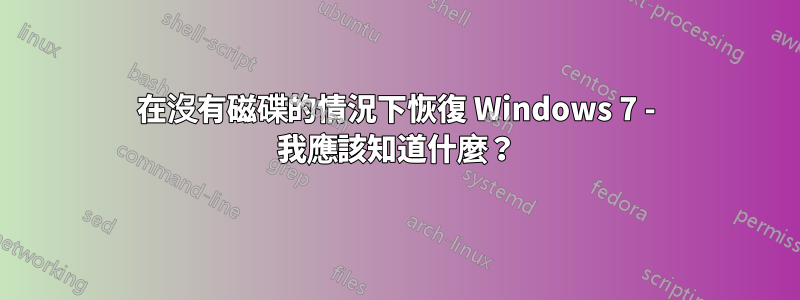
我的兄弟去年從頭開始組裝了一台計算機,並在上面安裝了 Windows 7 Ultimate 64 位元。問題是它現在需要恢復到出廠設定 - 原因是我的另一個兄弟想要安裝新遊戲並且不記得管理員密碼是什麼!
當將光碟插入電腦時(取決於要執行的程序,例如setup.exe),它會要求輸入管理員密碼,從而否定使用磁碟的選項,這一事實進一步加劇了這種情況。
我讀到,要執行此操作,應在彈出 Windows 7 圖像之前按下鍵盤上的正確鍵。所以問題實際上是什麼是正確的鍵?我知道它們取決於製造商,但取決於什麼?主機板、CPU 甚至硬碟?
之後會出現什麼畫面? (截圖可以很好地證明這一點)
任何可以完整解釋這一點的資源都會有所幫助。
謝謝!
答案1
如果您剛剛丟失了管理員密碼並且沒有“正常”方法來恢復它,我建議使用Hiren 的 BootCD
該網站提供了刪除管理員通行證所需的所有教程。
- 首先準備一個可啟動的USB。
- 將 Hiren 的檔案複製到 USB 上。
- 按照教程中的步驟進行操作 - 一切都很好且清晰。
答案2
開啟電腦或重新啟動電腦(如果已開啟)。
打開電腦後的最初幾秒鐘內,請注意「正在進入設定」訊息。此訊息因電腦而異,並且還包括進入 BIOS 所需按下的一個或多個按鍵。
以下是您可能會看到此 BIOS 存取訊息的一些常見方式:
Press [key] to enter setup
Setup: [key]
Enter BIOS by pressing [key]
Press [key] to enter BIOS setup
Press [key] to access BIOS
Press [key] to access system configuration
快速按下上一則訊息指示的一個或多個鍵進入 BIOS。
注意:您可能需要按幾次 BIOS 存取鍵才能進入 BIOS。請勿按住該鍵或按太多次,否則您的系統可能會出錯或鎖定。如果發生這種情況,只需重新啟動並重試。
當您進入 BIOS 時,您可以使用鍵盤上的按鍵導航 BIOS 選單,它看起來像這樣: http://0.tqn.com/d/pcsupport/1/0/H/2/-/-/biosmainmenu.jpg
只需轉到啟動選單並找到用於更改啟動順序的選項即可。首先放置您的 DVD/磁碟閱讀器,儲存並重新啟動。它應該從磁碟啟動,然後你可以這樣做: http://harryjohnston.wordpress.com/2010/03/09/resetting-a-password-in-windows-7-or-windows-vista/
我將從那裡複製粘貼,以防鏈接中斷:
Boot to your Windows 7 or Windows Vista installation DVD, whichever matches the installed OS. If you purchased your computer from a responsible vendor, they’ll have provided you with one, although unfortunately many vendors don’t.
Additional note 8 September 2011: In Windows 7, there is an option in the Start Menu (under Maintenance) to Create a System Repair Disc. The CD or DVD this option creates is perfect for the job. However, you have to be an administrator to use it, so unless you’ve done it ahead of time or can use a friend’s Windows 7 machine you’re out of luck.
Additional note 1 September 2011: If your computer is 64-bit capable (you don’t need to actually be running a 64-bit OS) then you can use the install disk for Microsoft’s free server product, Hyper-V. You can find it here. Note, however, that it is a fairly big download, a little more than a gigabyte.
Additional note 5 May 2011: Nommo was kind enough to point me to this post on Microsoft Answers which provides a link to downloadable repair disks for Vista and Windows 7. I can’t from my own knowledge confirm that these disks are legitimate, and Microsoft aren’t telling, so use only at your own risk. Indications are that they are probably OK. (Personally, I wouldn’t use the charged-download option until I’d checked how much my OEM was going to charge to provide an installation disk. Make sure the OEM knows you need a Windows installation disk, not a system recovery disk.)
A vendor system recovery disk might offer the same functionality, and in some cases you can order an installation DVD from your vendor (or from Microsoft?).
Select your language options on the first screen and press Next to continue.
Choose “Repair Your Computer”.
Choose “Use recovery tools…” and select your OS. Make a note of which drive letter it is on, e.g., C: or D:. This might not be the same drive letter you see when booted normally.
Additional note 1 September 2011: if you get an error message when you press Next, this might be because the install disk you are using is not compatible with the version of Windows you have installed. This will happen, for example, if you are using the Hyper-V install disk. Don’t panic. Just press SHIFT-F10 to open a command prompt and skip ahead to step 6.
Select Command Prompt.
In the command prompt window that appears, type “regedit” and press ENTER.
Select HKEY_LOCAL_MACHINE and then choose Load Hive from the File menu.
Find and open the file named SYSTEM on the drive you noted in step 4. If Windows is in the default configuration, this will be in windows\system32\config.
Enter a key name, e.g., “xxx”.
Click the plus icon to the left of HKEY_LOCAL_MACHINE to open this key. Select the xxx key.
Select Export from the File Menu. Change the Save as type to Registry Hive Files. Type a name for the backup, for example, systembackup, and press Save. (This step creates a backup of the unmodified SYSTEM registry hive as a precaution.)
Open the xxx key, and select Setup.
Double-click on SetupType in the right-hand pane. Enter 2 and press OK.
Double-click on CmdLine. Enter cmd.exe and press OK.
Close Registry Editor. Type “regedit” and press ENTER to open it again. (This step does not appear to be necessary in Windows 7, but in Windows Vista if you do not do this the next step might fail with an Access Denied error.)
Open HKEY_LOCAL_MACHINE, select xxx, and choose Unload Hive from the File Menu. Push Yes.
Close the command window and the Registry Editor. Remove the installation DVD and select Restart.
When your computer boots up, another command window should appear.
Type “net user foo bar”, replacing foo with the username of the account whose password you want to reset, and bar with the new password. For example, you might type “net user Administrator letmein”. Press ENTER.
If you want to use the built-in Administrator account, you will probably need to enable it: type “net user Administrator /active:yes” and press ENTER.
If you don’t know what the administrative username(s) are, type “net localgroup administrators” and press ENTER to find out.
Type “exit” and press ENTER.
When the logon screen appears, use the username and the new password to log in.


